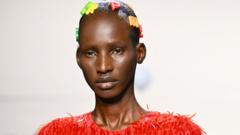As fashion houses increasingly favor slimmer models and embrace weight-loss solutions like Ozempic, many question the future of the body positivity movement.
The Fashion Industry's Shift: Is Body Positivity Now a Thing of the Past?

The Fashion Industry's Shift: Is Body Positivity Now a Thing of the Past?
A look into the current trends dominating fashion runways, revealing a resurgence of traditional beauty standards and the decline of body positivity.
In recent years, the fashion industry has witnessed a marked return to traditional beauty standards, causing concern among advocates for body positivity. During the 2010s, this movement thrived, promoting acceptance of diverse body types and striving for inclusion across the board. However, with the rise of weight-loss medications like Ozempic, insiders suggest that skinny models are regaining prominence on the runways, overshadowing the progress previously made.
The body positivity movement traces its roots back to the 1960s and saw a resurgence in the 2010s, bolstered by social media and the influence of celebrities such as the Kardashians. These changes fostered a new appreciation for curves, as plus-sized models like Ashley Graham began to gain recognition, featuring prominently on runways and magazine covers.
However, as we delve into fashion weeks today, the tangible effects of these advancements seem to be waning. Reports indicate that at major events like Paris Fashion Week, the visibility of plus-size models has dwindled significantly—just 0.8% of looks were attributed to these models during the recent season. This decline coincides with a cultural shift, as new weight-loss drugs have taken center stage in Hollywood, creating an environment where the once-celebrated diversity of body shapes appears to be reconceiving into nostalgia.
Some models express mixed feelings about this shift, acknowledging the strategic advantage of being slim yet grappling with the pressure to conform to these eternal standards. Industry figures like Chioma Nnadi, British Vogue’s editorial director, pointed out the risks linked to reverting to a focus on thinness. The rise of satirical fashion pieces, such as the controversial “I love Ozempic” shirt featured by the brand Namilia, raises eyebrows and highlights a tension between reality and the aesthetics being promoted.
Despite a clamor for inclusivity from certain designers, the struggle remains palpable. Casting directors have openly shared that many brands prioritize selling clothes over authentically embracing body diversity. One casting director lamented that the era of body positivity, which once seemed to offer promise, has seen brands revert to a narrow definition of beauty as a mere marketing strategy.
While some in the industry uphold their commitment to inclusivity, designers like Charles Jeffrey argue that fashion should be reflective of society's culture and community rather than adhering to outdated standards. Unfortunately, as insiders indicate, the celebration of body diversity increasingly seems like the exception, not the rule.
As consumers and participants of the fashion ecosystem, experts advocate that change can stem from purchasing habits; if consumers demand inclusivity, the brands will inevitably follow suit. With trends, there can be hope for resurgence. After all, history in fashion exhibits a cyclical nature, and as trends evolve, so too may attitudes toward body acceptance. The fashion world may yet position itself on a path back to embracing bodies of all sizes—if enough voices call for change and insist it be part of the conversation.
The body positivity movement traces its roots back to the 1960s and saw a resurgence in the 2010s, bolstered by social media and the influence of celebrities such as the Kardashians. These changes fostered a new appreciation for curves, as plus-sized models like Ashley Graham began to gain recognition, featuring prominently on runways and magazine covers.
However, as we delve into fashion weeks today, the tangible effects of these advancements seem to be waning. Reports indicate that at major events like Paris Fashion Week, the visibility of plus-size models has dwindled significantly—just 0.8% of looks were attributed to these models during the recent season. This decline coincides with a cultural shift, as new weight-loss drugs have taken center stage in Hollywood, creating an environment where the once-celebrated diversity of body shapes appears to be reconceiving into nostalgia.
Some models express mixed feelings about this shift, acknowledging the strategic advantage of being slim yet grappling with the pressure to conform to these eternal standards. Industry figures like Chioma Nnadi, British Vogue’s editorial director, pointed out the risks linked to reverting to a focus on thinness. The rise of satirical fashion pieces, such as the controversial “I love Ozempic” shirt featured by the brand Namilia, raises eyebrows and highlights a tension between reality and the aesthetics being promoted.
Despite a clamor for inclusivity from certain designers, the struggle remains palpable. Casting directors have openly shared that many brands prioritize selling clothes over authentically embracing body diversity. One casting director lamented that the era of body positivity, which once seemed to offer promise, has seen brands revert to a narrow definition of beauty as a mere marketing strategy.
While some in the industry uphold their commitment to inclusivity, designers like Charles Jeffrey argue that fashion should be reflective of society's culture and community rather than adhering to outdated standards. Unfortunately, as insiders indicate, the celebration of body diversity increasingly seems like the exception, not the rule.
As consumers and participants of the fashion ecosystem, experts advocate that change can stem from purchasing habits; if consumers demand inclusivity, the brands will inevitably follow suit. With trends, there can be hope for resurgence. After all, history in fashion exhibits a cyclical nature, and as trends evolve, so too may attitudes toward body acceptance. The fashion world may yet position itself on a path back to embracing bodies of all sizes—if enough voices call for change and insist it be part of the conversation.





















